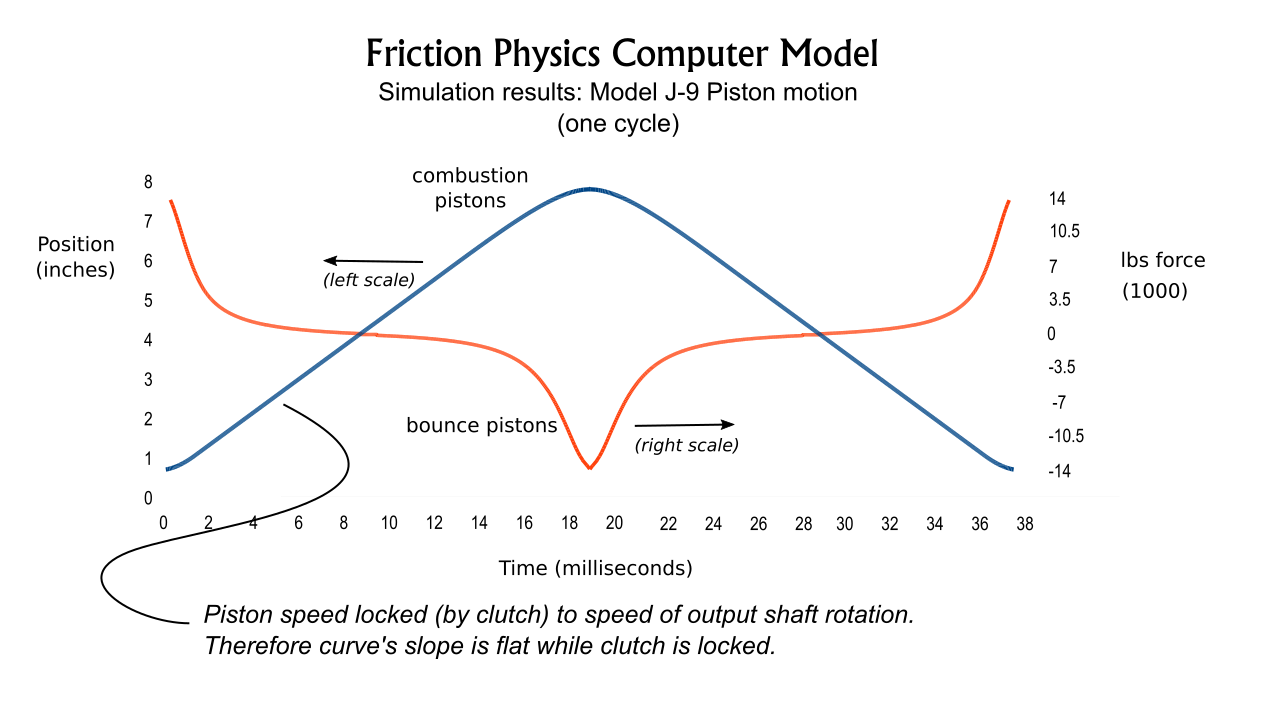Mobile Site: View in Landscape Mode
New low-friction, high efficiency engines made possible by the patented J-Clutch
X

X

Specifications and Thermodynamics
Friction Physics developed a detailed computer engine model that was proofed against standard aircraft engine performance. The Lycoming O-360 A1A was chosen to represent the current state of technology. Extensive performance data for the O-360 are available. After validation of the computer model against the O-360, Friction Physics presents simulation results for the model J-9 engine.
J-Drive engines provide:
- greater fuel efficiency
- greater power
- far cooler operation
- lower manufacturing cost
Page Contents
- 1Specifications
- 2Videos and Charts
Model J-9 Dimensions vs. O-360
| Characteristic | O-360 Simulation | O-360 Published | Model J-9 | notes |
|---|---|---|---|---|
| bore | 5.125 in | 5.125 in | 5.125 in | combustion cylinder/piston diameter |
| displacement | 361 cu-in | 361 cu-in | 506 cu-in | For Model J-9, displacement is volume of chamber when valves close, not a measure of piston sweep |
| compression stroke | 4.375 in | 4.375 in | 5.3 in | |
| power stroke | 4.375 in | 4.375 in | 6.24 in | J-Drive extended power stroke |
| Compression Ratio | 8.5 : 1 | 8.5 : 1 | 7 : 1 | |
| Fuel Type | AVGAS 100LL | automotive | ||
| percent Atkinson | 0 | 0 | 26% | by volume |
| weight | 258 lbs | ~370 lbs | ||
| power to weight ratio | 0.7 HP/lb | ~0.7 HP/lb |
Full Power, Sea Level Performance
| Characteristic | O-360 Simulation | O-360 Published | Model J-9 | notes |
|---|---|---|---|---|
| Power | 180 HP | 180 HP | 260 HP | |
| Fuel Rate | 16.2 gal/hr | 15-16 gal/hr | 15 gal/hr | |
| HP per (gal/hr) rate | 10.8 HP/gal | ~11.2 HP/gal | 18 HP/gal | inverse of gal/HP |
| EGT | 1440 °F | 1300 to 1400 °F | 1215 °F | Exhaust Gas Temp. |
| CHT | 363 °F | 350 to 435 °F | 331 °F | Cylinder Head Temp. |
| Engine Speed | 2700 RPM | 2700 RPM | 1625 Cycles/min | |
| power strokes/min | 5400 | 5400 | 6500 | |
| mixture (Φ) | 1.4 | "full rich" | 0.65 | mixture equivalency ratio (ϕ) |
| Air/Fuel ratio | 10.5 | - | 22.6 | 14.7 is stoichiometric |
| % fuel energy to shaft | 25.3% | - | 40% | fuel conversion efficiency |
| % burned fuel energy to exhaust | 46.6% | 44% | 45% | heat energy in expelled exhaust gas |
| power to engine heat | 64 kilowatts | - | 60 kilowatts | friction and conduction |
| BMEP | 1012 kPa | - | 815 kPa | Brake Mean Effective Pressure |
75% Power Cruise at 5000 feet altitude
| Characteristic | O-360 Simulation | O-360 Published | Model J-9 | notes |
|---|---|---|---|---|
| Power | 135 HP | 135 HP | 190 HP | |
| Fuel Rate | 9.8 gal/hr | 9.5-10 gal/hr | 11 gal/hr | |
| HP per (gal/hr) rate | 13.75 HP/gal | 17.6 HP/gal | inverse of gal/HP | |
| EGT | 1406 °F | 1350 to 1450 °F | 1000 °F | Exhaust Gas Temp. |
| CHT | 353 °F | 350 to 435 °F | 275 °F | Cylinder Head Temp. |
| Engine Speed | 2400 RPM | 2400 RPM | 1610 Cycles/min | |
| mixture (Φ) | 1.1 | rich of peak | 0.55 | mixture equivalency ratio (ϕ) |
| Air/Fuel ratio | 13.36 | - | 26.7 | 14.7 is stoichiometric |
| % fuel energy to shaft | 31.2% | 29-30% | 41% | fuel conversion efficiency |
| % fuel energy to exhaust | 43% | 44% | 42% | heat energy in expelled exhaust gas |
| power to engine heat | 63 kilowatts | - | 51 kilowatts | friction and conduction |
| BMEP | 850 kPa | - | 598 kPa | Brake Mean Effective Pressure |
click to expanded
P-V Diagram O-360 vs. J-9
Model J-9 piston velocity/position curve

